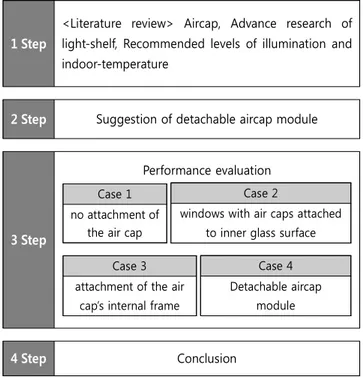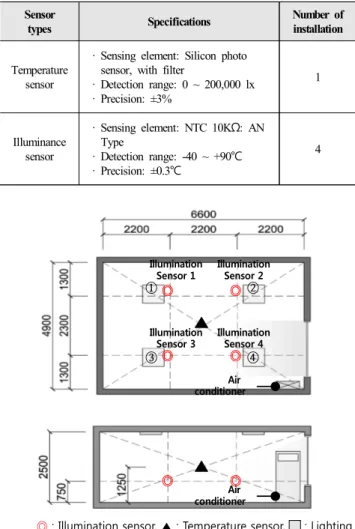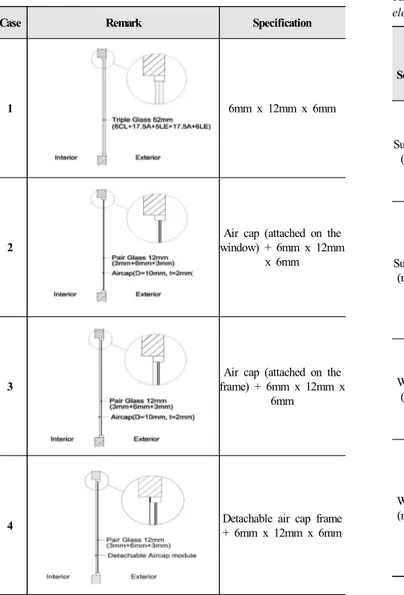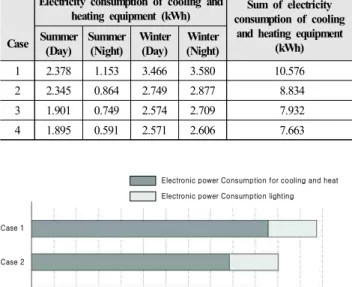1. 서론1)
1.1. 연구의 배경 및 목적
우리나라 국가 에너지 통계에 따르면 가정 부분을 제외한 비주 거용 건물에너지 소비는 2000년 이후에도 상대적으로 빠르게 증 가하고 있다. 2000~2014년 기간 중 비주거용 건물부분의 에너 지수요 증가율은 연평균 3.0% 증가하여 최종에너지 평균 증가율 (2.5%)보다 높은 수준을 나타냈다. 특히, 동 부분의 전력 소비가 2000~2014년년 기간 중 연평균 5.7%의 높은 증가세를 기록하 여 건물부분에서 전력이 차지하는 비중은 2000년 43%에서 2014년에는 62%로 확대되었다.1) 이러한 건물 에너지 소비 증가 의 다양한 원인 중 열 손실에 의한 소비로서써 건물부문의 창호는 에너지 손실과 관련하여 취약한 부분으로 에너지 손실이 높게 나
pISSN 2288-968X, eISSN 2288-9698 http://dx.doi.org/10.12813/kieae.2017.17.1.063
타나고 있어서 이를 해결하고자 하는 다양한 기술개발과 연구의 수요는 증가하고 있다.
이러한 연구 중 에어캡은 완충포장용도로 개발되었으나, 최근 단열성능 및 경제성을 입증 받아서 다양한 연구와 함께 적용 사례 가 증가하고 있다. 그러나 에어캡 관련한 기존 연구는 에어캡의 규격 및 부착 위치에 따른 단열성능평가에만 치중되어 진행하였 으며, 에어캡의 탈부착에 대한 편의성을 고려한 연구는 부재한 실 정이다. 또한 에어캡 적용 시 실내로 유입되는 자연광의 유입량이 감소되어 빛환경 저하 및 조명에너지 사용량이 증가되어서 에어 캡 적용시 빛환경을 고려한 성능평가가 반드시 반영되어야 함에 도 이러한 요인을 고려한 연구는 부재하다.
이에 본 연구는 창호 성능 개선 및 에어캡 부착의 편의성을 개 선한 에어캡 탈부착형 모듈 개발을 실시하며, 이후 실스케일의 테스트베드를 구축하여 냉난방환경 및 빛환경 기반의 에너지 성 능평가를 진행하여 유효성 검증을 목적으로 한다.
KIEAE Journal
Korea Institute of Ecological Architecture and Environment
83
창호 성능 개선을 위한 에어캡 탈부착형 모듈 개발
Development of detachable air-cap module for improving the performance of windows
서범동*⋅이행우**⋅서장후***⋅김용성****
Seo, Beomdong*⋅Lee, Heangwoo**⋅Seo, Janghoo***⋅Kim, Yongseong****
* Dept. of Architectural Design, Graduate School of Techno Design, Kookmin University., South Korea (raintiger@naver.com) ** Dept. of Architectural Design, Graduate School of Techno Design, Kookmin University., South Korea (moonup2001@nate.com)
*** School of Architecture / Dept. of Architectural Design, Graduate School of Techno Design, Kookmin University., South Korea (seojh@kookmin.ac.kr)
**** Corresponding author, Dept. of Architectural Design, Graduate School of Techno Design, Kookmin University., South Korea (yongkim@kookmin.ac.kr)
A B S T R A C T K E Y W O R D
Purpose: Various studies to solve the problem of increased energy consumption in the buildings are being carried out recently. Especially, the economic feasibility and insulation performance of the air-cap have been verified so that various studies regarding the reduction of building energy consumption have been carried out. However, previous studies regarding the air-cap were only carried out based on the verification of its insulation performance according to the size and attachment position of the air-cap. Therefore, the purpose of this study is to suggest a detachable air-cap module for improving the performance of the windows, evaluate the performance based on cooling, heating and light environments and verify its effectiveness through a real-scale testbed. Method: In this study, the energy saving performance in the circumstance where there is no attachment of an air-cap (Case 1), the circumstance where there is the attachment of air-cap on the glass surface of window (Case 2) and the circumstance where there is the attachment of an air-cap on the window frame (Case 3) were compared in order to verify the performance of the detachable air-cap module (Case 4), and the electricity consumption of cooling, heating and lighting equipment to maintain the appropriate indoor temperature and Illuminance for each case was calculated and utilized as indicators for the performance evaluation. Result: The result of this study is as follows. 1) In this study, the detachable air-cap module which was easily detachable through the principle of the magnet was suggested. 2) When Case 4 is applied, the electricity consumption of cooling and heating equipment can be reduced by 27.5%, 13.2% and 3.4% in comparison with Case 1, Case 2 and Case 3 respectively. 3) When the air-cap is applied to the window, the lighting energy consumption increases by 4 % in comparison to the non application of the air-cap, and this factor or aspect should be considered when applying the air-cap. 4) According to the performance evaluation result in consideration of cooling, heating and light environments, Case 4 demonstrates an energy saving ratio of 22.6%, 10.6% and 2.7% in comparison to Case 1, Case 2 and Case 3 respectively, indicating that it is effective for improving the performance of windows.
ⓒ 2017 KIEAE Journal 창호 에어캡 탈부착 성능평가 에너지저감
Window Aircap Detachable Type Performance evaluation Energy Saving
A C C E P TA N C E I N F O Received Oct 4, 2016
Final revision received Jan 5, 2017 Accepted Jan 10, 2017
1.2. 연구의 방법 및 범위
본 연구는 에어캡 적용의 편의성 및 성능개선을 위한 에어캡 탈부착형 모듈을 개발하며, <Fig. 1.>과 같은 절차에 의거하여 진행하였다. 첫 번째, 에어캡의 개념 및 선행연구를 고찰하며, 성 능평가를 위한 실내공간의 적정온도 및 적정조도 기준을 설정하 였다. 두 번째, 고찰된 내용을 기반으로 에어캡 탈부착형 모듈을 제안하였다. 세 번째, 제안된 에어캡 탈부착형 모듈의 유효성을 검증하기 위하여 에어캡 미설치, 기존의 에어캡 적용 방법인 창 호유리면 부착 및 창호 프레임 부착과의 에너지저감 성능평가를 진행하였다.
단 본 연구의 에너지저감 성능평가는 실스케일의 테스트베드 를 통하여 진행하였으며, 적용 Case에 따른 냉난방기기 및 조명 기기의 전력사용량을 산출하여 성능평가의 지표로 활용하였다.
또한, 본 연구의 에너지 성능평가는 냉난방기기의 가동이 이루어 지는 하지 및 동지에 대하여만 성능평가를 진행하였다.
1 Step
<Literature review> Aircap, Advance research of light-shelf, Recommended levels of illumination and indoor-temperature
2 Step Suggestion of detachable aircap module
3 Step
Performance evaluation Case 1
no attachment of the air cap
Case 2
windows with air caps attached to inner glass surface Case 3
attachment of the air cap’s internal frame
Case 4 Detachable aircap
module
4 Step Conclusion
Fig. 1. Flowchart of study
2. 에어캡 개념 및 연구동향, 실내 환경 기준 고찰
2.1. 에어캡 개념
에어캡은 미국의 Sealed Air Corperation2) 회사에서 개발한 제품으로서 두 장의 폴리에틸렌(Polyethylene) 필름을 포개어 그 사이에 공기를 충진하여 완충포장용으로 사용되었으나, 최근 에는 건물 창호의 단열성능개선을 위한 재료로 활용되고 있다.
에어캡 제조업체의 정보를 근거한 에어캡의 규격은 <Table 2.>
에서 나타나듯이 다양하게 보이고 있으나, 본 연구는 기존 선행연 구3)에서 다루고 있는 지름 10mm의 원형 공기층의 타입 2를 적용 하여 성능평가를 진행하였다.
Title of study (Year)
Consideration of air-cap attachment method
Performance evaluation Heat insulation property(Heating/
Cooling)
Lighting
A Comparative Evaluation on the Thermal Insulation
Performance of Windows according to
the Temporary Improvement Method.3) (2015)
× ○ ×
Thermal Performance Evaluation of the Window Systems with
Air-bubble Sheets4) (2015)
× ○ ×
Table 1. Advance research of aircap
Type D
(Diameter of air layer)
t
(Thickness of coating layer) 1
10 mm
0.2mm
2 0.3mm
3 20mm
0.6mm
4 30mm
<Aircap section>
Table 2. Aircap size and components
2.2. 에어캡 관련 선행연구 고찰
에어캡과 관련한 국내의 선행연구는 <Table 1.>과 같이 2건 으로 나타나며, 에어캡 관련 선행연구는 에어캡의 규격 및 부착 위치에 따른 단열성능 평가만 진행되었다. 이는 본 연구가 제안 하는 에어캡 탈부착형 모듈의 유효성을 의미하며, 본 연구의 성 능평가 간 에어캡 적용에 따른 실내 조도 저하 및 조명 기기의 사 용량 반영은 기존 연구와 차별화 및 고도화 된다.
2.3. 실내 적정 온도 및 조도 기준 고찰
실내의 적정 온도 및 조도를 유지하는 것은 거주자의 쾌적성 과 냉난방 및 조명에너지 저감을 동시에 만족시킬 수 있는 중요 한 부분이다5). 이에 본 연구는 <Table 3.> 및 <Table 4.>과 같이 실 내의 권장 온도 및 조도 기준을 고찰하였으며, 이후 성능평가를 위한 실내 적정 온도는 표준화 기구인 ISO 10211기준6)에 근거하여 하지 및 동지에 대하여 각각 26℃, 20℃로 설정하여 성능평가를 진행하였 다. 또한 실내 적정조도는 KS A 30117)를 근거하여 일반휘도 대비 시
작업의 평균조도인 400 lx를 성능평가를 위한 실내 적정 조도 및 조 명제어를 위한 기준으로 설정하였다.
Recommended temperature standard of indoor space (℃) Summer : 23.0~26.0 Winter : 20.0~23.5 Table 3. Recommended temperature standard of indoor space:
ISO-based, recommended indoor temperature
Type of activity
Scope
Min Ave Max
Visual performance according to the
degree of general-brightness 300 400 600 Table 4. Standard illuminance of KS A 3011
3. 에어캡 탈부착 모듈 제안 및 성능평가
3.1. 에어캡 탈부착 모듈 제안
본 연구의 에어캡 탈부착 모듈은 <Fig. 2.>와 <Fig. 3.>과 같 이 기존의 탈부착 기능을 갖는 방충창용 모서리조립체8)를 착안 하였으며, 창호와 에어캡에 각각 줄자석을 부착하여 손쉽게 탈부 착이 가능하도록 하였다. 또한, 에어캡 탈부착 모듈은 기존 연구 의 에어캡 성능평가 결과4)를 근거하여 창호의 프레임에 부착하 도록 하였으며, 줄자석과 창호 프레임, 줄자석과 에어캡의 부착 은 양면형 단열테이프로 부착하여 기밀성 및 단열성이 개선되도 록 하였으며, 에어캡 탈부착 모듈 프레임은 단면형 단열 테이프 로 마감 처리하였다.
①
②
③
④
⑤
⑥
⑦
⑧
① : Window frame
② : Insulation tape(Thk. 1.2mm)
③ : Magnet(Thk. 1mm)
④ : Insulation tape(Thk. 1.2mm)
⑤ : Aircap
⑥ : Insulation tape(Thk. 1.2mm)
⑦ : Magnet(Thk. 1mm)
⑧ : Detachable aircap frame Fig. 2. Suggestion of detachable air-cap module(Section)
Window Magnet Insulation Magnet
tape Aircap
Insulation tape
Detachable aircap frame
Fig. 3. Suggestion of detachable air-cap module(Method of attachment)
본 연구에서 제안하는 에어캡 탈부착 모듈의 설치는 <Table 5.>과 같이 다음의 절차에 의거하여 진행하도록 제안한다. 우선 줄자석을 창 호의 프레임의 4면에 부착한 후, 창호의 크기에 맞추어 에어캡을 절단 하며, 절단된 에어캡과 에어캡 탈부착 프레임을 부착한다. 이에 자석효 과를 통하여 에어캡 탈부착이 가능하다.
① Attach the string magnet to the
window frame ② Cut the air-cap
③ Attach the air-cap module ④ Detach the air-cap module Table 5. Installation process of detachable air-cap module
3.2. 성능평가 환경설정
본 연구는 에어캡 탈부착 모듈의 성능평가를 진행하기 위하여 실스 케일의 테스트베드를 구축하였으며, 테스트베드는 <Table 6.>과 같이 폭 4.9m, 높이 2.5m, 깊이 6.6m의 크기이다. 에어캡이 부착되는 창호의 크기는 폭 2.2m, 높이 1.8m이며, 창호의 크기는 국토해양부의 창호 설 계 가이드라인8)에서 제시하는 창면적비 40% 이하시 에너지저감에 유 효하다는 내용을 근거하여 조정한 결과이다. 또한, 테스트베드의 외부 에는 인공기후환경 조성이 가능하도록 챔버를 구축하였으며, 챔버는 광원의 광량, 높이, 각도 설정이 가능한 인공태양광 조사장치를 설치하 였다. 또한, 챔버는 –20℃에서 40℃의 온도 설정이 가능하여 다양한 외부환경 조성이 가능하도록 하였다.
단, 본 연구의 인공태양광 조사장치는 태양의 시간대별 방위 각 설정을 불가하며, 이에 따라서 성능평가는 정남형의 상황에 대하여만 진행하였다. 또한, 하지 및 동지에 대한 외부조도 및 온 도 설정은 관련연구9)를 근거하여 <Table 7.>과 같이 각각 8만 lx 및 3만 lx로 설정하였다. 일사량은 인공태양광 조사장치에 의 해서 도출되는 값으로 설정하였으며, 에어캡 탈부착형 모듈이 부
착되는 창호와 면하는 챔버의 온도 설정은 하절기시 34℃, 동절 기시 –10℃로 설정하여 진행하였다.
Testbed
Room size 4.9m(w) × 6.6m(D) × 2.5m(H) Wall
material Insulation panel(Thk 100mm) Window
size 1.9m(W) × 1.7m(H)
Window material9)
Type Pair glass 24mm
(6mm+12mm+6mm) Thermal
transmittance
Summer: 2.83W/m²K Winter: 2.69W/m²K
Transmissivity 80%
Directions South aspect
View of testbed Table 6. Overview of testbed, chamber
Season External temperature
External illumination
Solar radiation quantity
Summer 34℃ 80,000 lx 503 W/m2
Winter –10℃ 30,000 lx 340 W/m2
Table 7. External temperature, external illuminance and amount of solar radiation on summer solstice and winter solstice
테스트베드는 <Table 8.>과 같이 냉난방기기11) 및 조명기기 를 설치하였으며, 냉난방기기는 실내의 온도센서와 연동하여 On/Off 제어가 이루어지도록 하기 위하여 S사와 기술 협조를 통 하여 구축하였다. 또한 조명은 8단계의 디밍 조명제어가 가능한 LED 타입의 조명을 설치하였으며, 조명의 위치는 IES의 4점법 에 의거하였다.
Air conditioner
Model AP-SM302(EHP)
Heating / Cooling capacity 13,200w / 11,000w
Heating consumption 3.90kw
Cooling Consumption 3.90kw
COP Heating: 3.38 / Cooling: 2.82
Lighting
Dimming control(8 level), LED type / Energy Consumption for Phased Light Dimming : Level 1(12.3kWh), Level 2(18.3kWh), Level 3(22.0kWh), Level 4(27.7kWh), Level 5(34.0kWh), Level 6(38.5kWh),
Level 7(42.6kWh), Level 8(50.8kWh), Table 8. Specifications of cooling, heating and lighting equipment
성능평가를 위하여 <Table 9.>와 <Fig. 4.>과 같이 온도센 서와 조도센서를 설치하였으며, 온도센서는 실내공간의 정중앙 에 위치시켰다. 또한, 조도센서의 위치는 실내공간의 평균조도 를 측정하기 위한 조도센서의 위치가 채광창으로부터 4.4m 지점
이 적합하다는 연구결과12)를 근거로 조정하여 채광창으로부터 2.2m 및 4.4m에 각각 설치하였다.
Sensor
types Specifications Number of
installation
Temperature sensor
· Sensing element: Silicon photo sensor, with filter
· Detection range: 0 ~ 200,000 lx · Precision: ±3%
1
Illuminance sensor
· Sensing element: NTC 10KΩ: AN Type
· Detection range: -40 ~ +90℃
· Precision: ±0.3℃
4 Table 9. Specifications of temperature and illuminance sensor for performance evaluation
① ②
③ ④
◎ ◎
◎ ◎
◎
▲
◎▲
Illumination Sensor 1
Illumination Sensor 2
Illumination Sensor 3
Illumination Sensor 4
Air conditioner
Air conditioner
◎ : Illumination sensor, ▲ : Temperature sensor, : Lighting Fig. 4. Plane, cross-section of the testbed and location of sensor
3.3. 성능평가 방법
본 연구에서 <Table 10.>과 같이 제안하는 에어캡 탈부착 모 듈의 성능평가 방법은 다음과 같다.
첫 번째, 본 연구는 에어캡 탈부착 모듈(Case 4)의 성능평가 를 위하여 에어캡 미설치(Case 1)와 창호 유리면 에어캡 부착 (Case 2) 및 창호 프레임 에어캡 부착(Case 3)과 에너지 저감 성 능 평가를 진행하였다.
두 번째, 본 연구의 에너지 성능평가를 진행하기 위해 Case2,3의 부착 방법은 다음과 같다. Case2의 경우 유리면에 물 을 뿌린 다음 에어캡을 부착하였으며, Case3의 경우 양면 비닐 테이프를 프레임에 붙여 에어캡을 부착하는 방식으로 실험을 진 행하였다.
세 번째, 본 연구는 에너지 성능평가를 진행하기 위하여 각 Case 별 하지 및 동지의 설정된 실내 온도 유지를 위한 냉난방기 기가 자동적으로 제어되도록 하였으며, 냉난방기기의 제어에 따
른 전력사용량을 산출하였다. 냉난방기기의 전력사용량은 주간 및 야간에 대하여 각각 5시간으로 설정하여 진행하였다.
네 번째, 본 연구는 각 Case 별 실내 조도를 400 lx를 만족시키 기 위하여 조명제어를 실시하였으며, 이후 조명제어에 따른 조명 전력사용량을 산출하였다. 조명제어는 다음의 절차에 의하여 진 행하였다. 본 연구에서 설정된 조도센서 1, 2, 3, 4는 조명 1, 2, 3, 4와 연동하였으며, 각각의 조명은 연동된 조도 센서의 측정값에 의하여 자동 디밍제어되도록 하였다. 우선 수집되는 조도센서의 측정값을 근거로 400 lx이하의 값이 있을 경우에만 조명 제어는 실시되며, 가장 낮은 조도값을 가지는 조명과 연동되는 조명부터 순차적으로 디밍 조명제어가 이루어지도록 하였다. 단, 조명 디 밍제어 중 모든 조도센서의 값이 400 lx 이상을 만족하는 경우에 는 조명제어가 종료되도록 하였으며, 조명제어를 위한 조도기준 인 400 lx는 앞서서 고찰한 KS A3011를 근거하여 설정한 값이 다. 이후 조명제어가 종료된 상태의 값을 근거로 조명 사용량을 산출하였으며, 냉난방기기의 전력사용량은 주간 5시간 야간 5시 간에 대하여 성능평가을 진행하나 주야간의 성능평가로 각각 분 리하여 진행하였다. 이는 인공기후환경 기반의 성능평가에 기인 한 본 연구의 제한적인 요소이다.
Case Remark Specification
1 6mm x 12mm x 6mm
2
Air cap (attached on the window) + 6mm x 12mm
x 6mm
3
Air cap (attached on the frame) + 6mm x 12mm x
6mm
4 Detachable air cap frame
+ 6mm x 12mm x 6mm Table 10. Overview of experiment
3.4. 성능평가 결과
본 연구에서 제안하는 창호 성능 개선을 위한 에어캡 탈부착형 모 듈(Case 4)의 성능평가 결과는 <Table 11.> 및 <Table 12.>과 같으 며, 분석 내용은 다음과 같다.
첫 번째, 에어캡 탈부착형 모듈(Case 4)을 적용시 에어캡 미설치 (Case 1), 창호 유리면 에어캡 부착(Case 2) 및 창호 프레임 에어캡 부착(Case 3)에 대비하여 냉난방 에너지저감은 각각 27.5%, 13.3%, 3.4%으로 나타난다. 특히, 본 연구에서 제안하는 탈부착형 에어캡 모듈은 기존 연구에서 수행한 테입처리를 통한 부착방법인 창호 프레임 에어캡부착 방법보다 우수한 성능을 보여 유효하게 분 석된다.
두 번째, 창호 성능개선을 위한 에어캡의 적용시는 에어캡 미적용 시에 대비하여 조명기기의 전력사용량은 4%의 증가량을 보이고 있 으며, 이는 에어캡 적용시 고려해야 할 요소이다.
세 번째, 냉난방환경 및 빛환경을 고려한 에너지 성능평가 결과
<Fig. 5.>과 같이 본 연구에서 제안하는 에어캡 탈부착형 모듈(Case 4)은 에어캡 미설치(Case 1), 창호 유리면에어캡 부착(Case 2) 및 창 호 프레임 에어캡 부착(Case 3)에 대비하여 22.6%, 10.6%, 2.7%의 에너지 저감률을 보여 창호 성능 개선에 효율적이라 분석된다.
Illumination Sensor (lx) Lighting dimming control
: Lighting Number (Dimming level)
Electricity consumption
for lighting (kWh)
Season Case 1 2 3 4
Summer (day)
1 85.7 210.1 114.1 429.5 1(8)→3(3) 0.364 2 76.3 185.0 98.5 384.3 1(8)→3(4) 0.392 3 74.8 181.3 97.5 376.6 1(8)→3(4) 0.392 4 74.1 177.5 94.5 371.8 1(8)→3(4) 0.392
Summer (night)
1 0 0 0 0 1(8)→3(8)→2(8)
→4(3) 0.900
2 0 0 0 0 1(8)→3(8)→2(8)
→4(3) 0.900
3 0 0 0 0 1(8)→3(8)→2(8)
→4(3) 0.900
4 0 0 0 0 1(8)→3(8)→2(8)
→4(3) 0.900
Winter (day)
1 417.1 607.3 714.5 25499.3 - 0
2 392.1 558.7 657.3 23459.4 1(8) 0.062 3 390.8 543.5 644.2 22980.2 1(8) 0.062 4 388.7 538.0 634.8 22820.3 1(8) 0.062
Winter (night)
1 0 0 0 0 1(8)→3(8)→2(8)
→4(3) 0.900
2 0 0 0 0 1(8)→3(8)→2(8)
→4(3) 0.900
3 0 0 0 0 1(8)→3(8)→2(8)
→4(3) 0.900
4 0 0 0 0 1(8)→3(8)→2(8)
→4(3) 0.900
Table 11. Result of performance evaluation : Calculation of electricity consumption for lighting
Electricity consumption of cooling and
heating equipment (kWh) Sum of electricity consumption of cooling
and heating equipment (kWh) Case Summer
(Day)
Summer (Night)
Winter (Day)
Winter (Night)
1 2.378 1.153 3.466 3.580 10.576
2 2.345 0.864 2.749 2.877 8.834
3 1.901 0.749 2.574 2.709 7.932
4 1.895 0.591 2.571 2.606 7.663
Table 12. Result of performance evaluation: Electricity consumption of cooling and heating equipment
Electronic power Consumption for cooling and heat Electronic power Consumption lighting
Total consumption power (kWh) Case 1
Case 2
Case 3
Case 4
Fig. 5. Electricity consumption of cooling, heating and lighting equipment for each case
4. 결론
본 연구는 건물의 에너지 손실이 높게 나타나고 있는 창호 성 능 및 에어캡 적용의 편의성 개선을 위한 에어캡 탈부착형 모듈 을 제안하며, 실제 스케일의 테스트베드를 통한 성능검증을 진행 하였다. 이에 대한 결론은 다음과 같다.
첫 번째, 본 연구는 자석의 원리를 적용하여 손쉽게 탈부착이 가능한 에어캡 탈부착형 모듈을 제안하여 에어캡 적용의 편의성 을 증대하였다.
두 번째, 에어캡 탈부착형 모듈(Case 4)은 에어캡 미설치 (Case 1), 창호 유리면에어캡 부착(Case 2) 및 창호 프레임 에 어캡 부착(Case 3)에 대비하여 냉난방 에너지 사용량이 각각 27.5%, 13.2%, 3.4% 저감되어 유효하게 분석된다.
세 번째, 에어캡이 적용되는(Case2,Case3,Case4) 창호는 적 용되지 않은 창호(Case1)에 대비하여 조명에너지 사용량이 4%
증가하고 있으며, 이는 에어캡 적용시 고려해야 할 요소이다.
네 번째, 에어캡 탈부착형 모듈(Case 4)은 냉난방환경 및 빛 환경을 고려한 성능평가 결과 에어캡 미설치(Case 1), 창호 유 리면에어캡 부착(Case 2) 및 창호 프레임 에어캡 부착(Case 3) 에 대비하여 22.6%, 10.6%, 2.7%의 에너지 저감률을 보여 창호 성능 개선에 효율적이라 분석된다.
본 연구는 에어캡의 적용시 가지는 문제점을 해결학기 위하여 탈부착 시스템을 도입하였으며, 동시에 성능을 극대할 수 있도록 가이드프레임을 제안하였다는 점에서 유의미하나, 성능평가 방 법에 있어 인공환경 및 특정 상황에 대하여 진행하였다는 점은
제한적인 요소라 판단된다. 향후에는 실제 환경을 기반으로 시간 대별 태양의 위치에 따른 조도 변화 및 다양한 변인을 고려한 연 구가 후속되어야 할 것이다.
Acknowledgements
This work was supported by the National Research Foundation of Korea Grant funded by the Korean Government(NRF-2016R1C1B1006807)
Reference
[1] 에너지경제연구원, “건물 에너지소비 상설표본조사 연구(2차년도)”, 기 본 연구 보고서 15-22, 2015 // (Korea Energy Economics Institute, Building Energy Consumption Standing Sampling Survey 15-22, 2015) [2] Sealed Air Corperation Homepage : http://sealedair.com
[3] 이성진, 김정국, 김종훈, 장학근, 이진숙, 장철용, “창호의 단열성능 간이 개선방법의 비교 분석”, 한국생태환경건축학회 논문집 제15권 제1호, 2015.02 // (Lee, Sung-Jin, Kim, Jeong-Gook, Kim, Jong-Hun, Jeong, Hak-Geun, Lee, Jin-Sook, Jang, Cheol-Yong, A Comparative Evaluation on the Thermal Insulation Performance of Windows according to the Temporary Improvement Method., Jornal of the Korea Institute of Ecological Architecture and Environment Vol.15 No.1, 2015.02
[4] 황제, 정아희, 전병헌, 안영철, “단열시트(뽁뽁이)의 종류 및 부착위 치에 따른 창호의 단열성능 평가”, 설비공학논문집 제27권, 제9호, 2015.09 // (Hwang, Je, Jeong, Ah-Hee, Jeon, Byung-Heoun, Ahn, Young-Chull, Thermal Performance Evaluation of the Window Systems with Air-bubble Sheets, Korean Jornal Of Air-Conditioning and Refrigeration Engineering Vol.27 No.9, 2015.09)
[5] 서태원, 이행우, 김용성, “주거공간 내 사용자인식기술 적용 조명에 너지 저감 광선반 시스템 연구”, 대한건축학회논문집 계획계, 제28 권 제11호, 2012.11 // (Seo, Tae-Won, Lee, Haeng-Woo, Kim, Yong-Seong, A Study on Light-Shelf System using Context Awareness Technology for Energy Saving in Housing Space, Jornal of the Architectural Institute of Korea Planning & Design, Vol.28 No.11, 2012.11)
[6] 장향인, 유동철, 안형준, 오향옥, 조대구, “ISO 10211 전열해석을 통한 경량목구조의 주요 구조부 단열성능 데이터베이스 구축”, 대 한건축학회논문집 계획계, 제3권 제4호, 2015 // (Jang Hyangin, Yoo Dongchul, Ahn Hyungjune, Oh Hyangok, Cho Deagu, Establishing a Thermal Performance Database for Major Structural Components of Lightweight Wood-frame House through ISO 10211 Heat Transfer Analysis. Journal of the architectural institute of Korea planning &
design, Vol.3, No.4, 2015.04)
[7] Korean Standards & Certification Homepage : http://standard.go.kr [8] 김종인, 심서래, 정순옥, “탈부착 기능을 갖는 방충창용 모서리조립
체”, 특허 등록번호 10-1337996, 2013.12 // (Kim, Jong-In, Shim, Suh-Rye, Chung, Soon-Ok, “Corner connector for anti-chassis frame with adhesion and separation function”, Patent registration number 10-1337996, 2013.12)
[9] 국토교통부, “건축물 에너지 절약을 위한 창호 설계 가이드라인”, 2012 // (Ministry of Land, Infrastructure, and Transport, Window Design Guidelines for the Building Energy 2012)
[10] 박유진, 실내로 유입되는 주광조도의 시간별 조도측정에 관한 연 구, 계명대학교 학위논문, 2007.02 // (Park, Eui-Jin, A Study on the Daylight Flowing into A Building Interior According to the Luminous of Every Hour, Department of Architectural Engineering Graduate School Keimyung University, 2007.02)
[11] SANMSUNG HOMPAGE: http://www.samsung.com
[12] 정봉근, 최안섭, “광센서 조광제어시스템의 광센서 최적 방향성과 위치에 관한 실험적 연구”, 조명·전기설비학회논문지, 제17권 제5 호, 2003 // (Jung Bongkeun, Choi Anseop, An Experimental Study of the Optimum Spatial Characteristics and Location of Photosensor for Daylight Responsive Dimming Systems. Journal of the Korean institute of illuminating and electrical installation Engineers, Vol.17, No.5, 2003.09)




